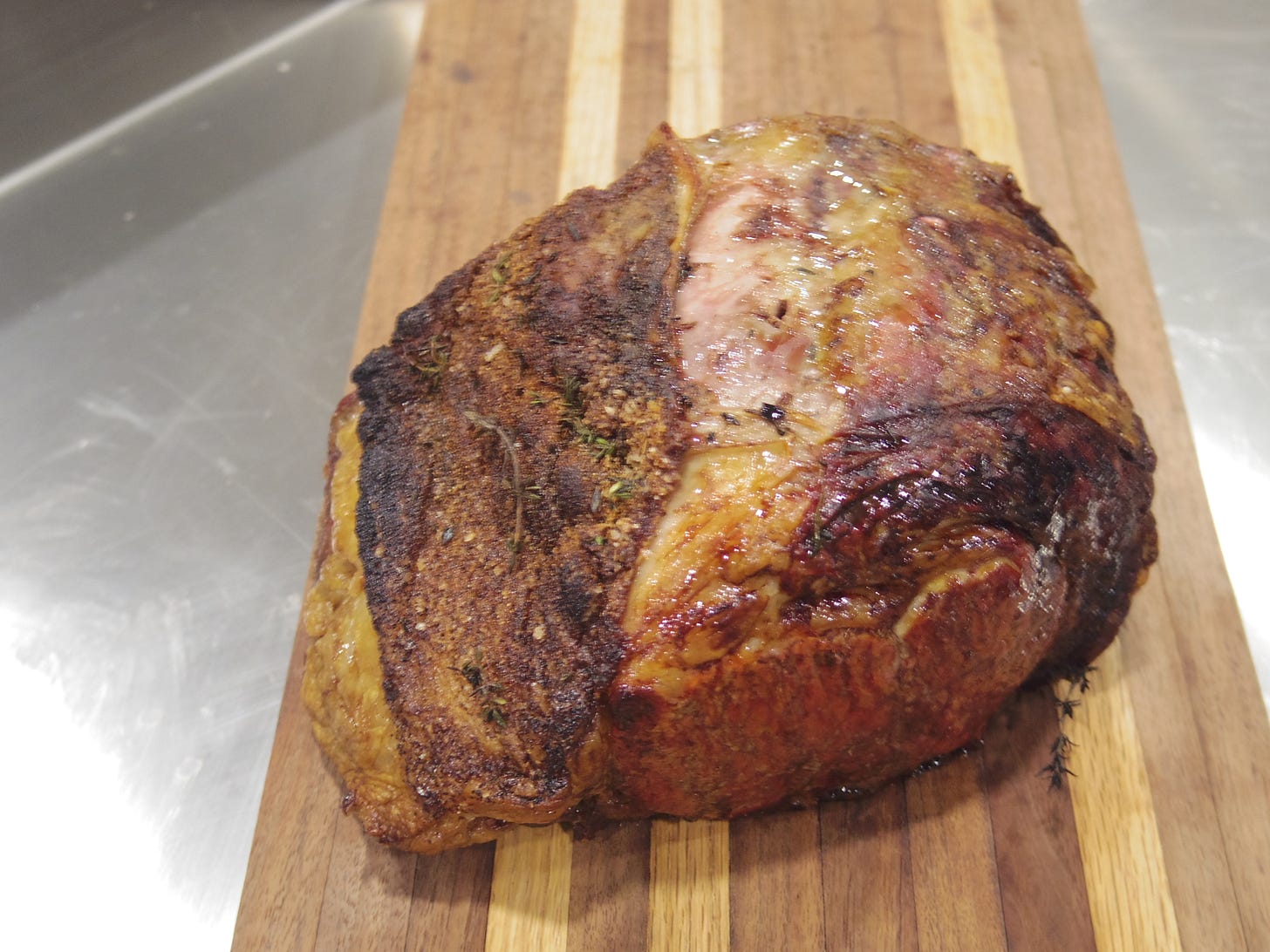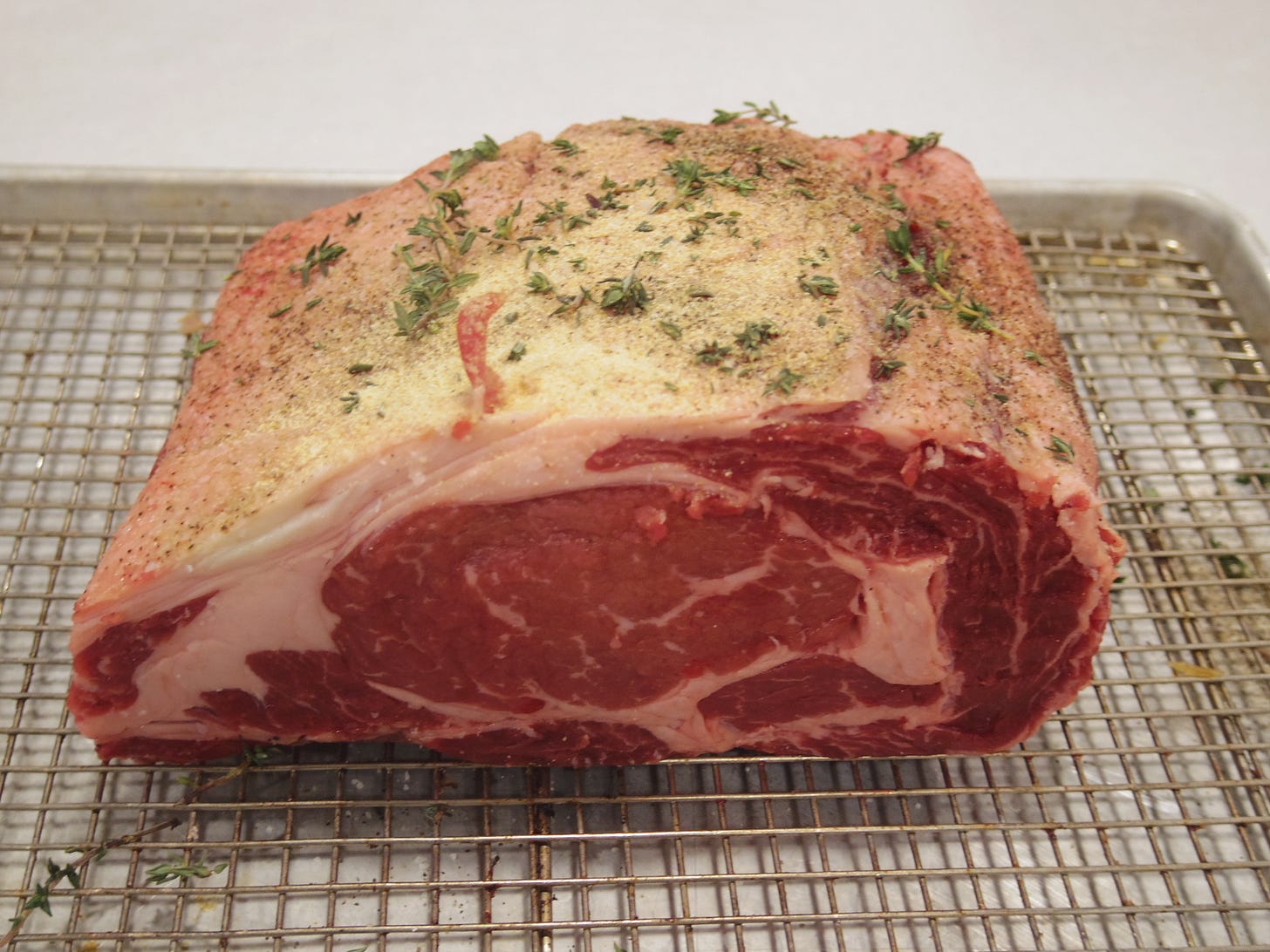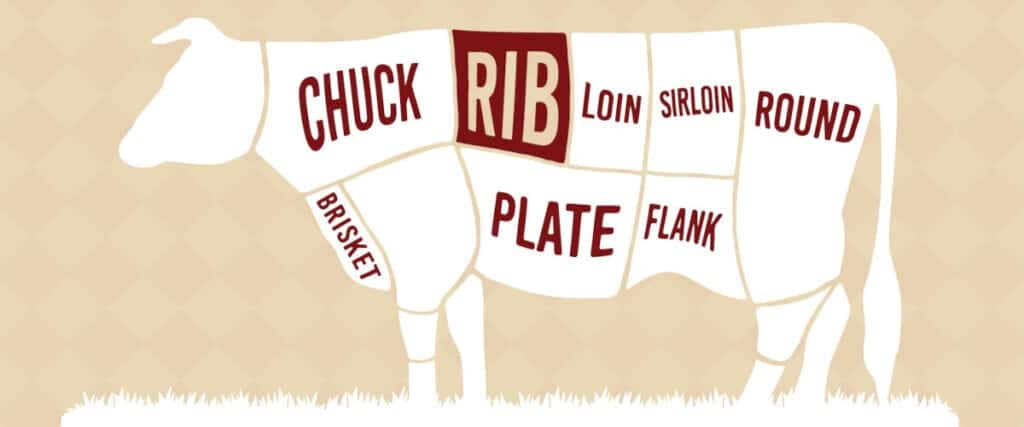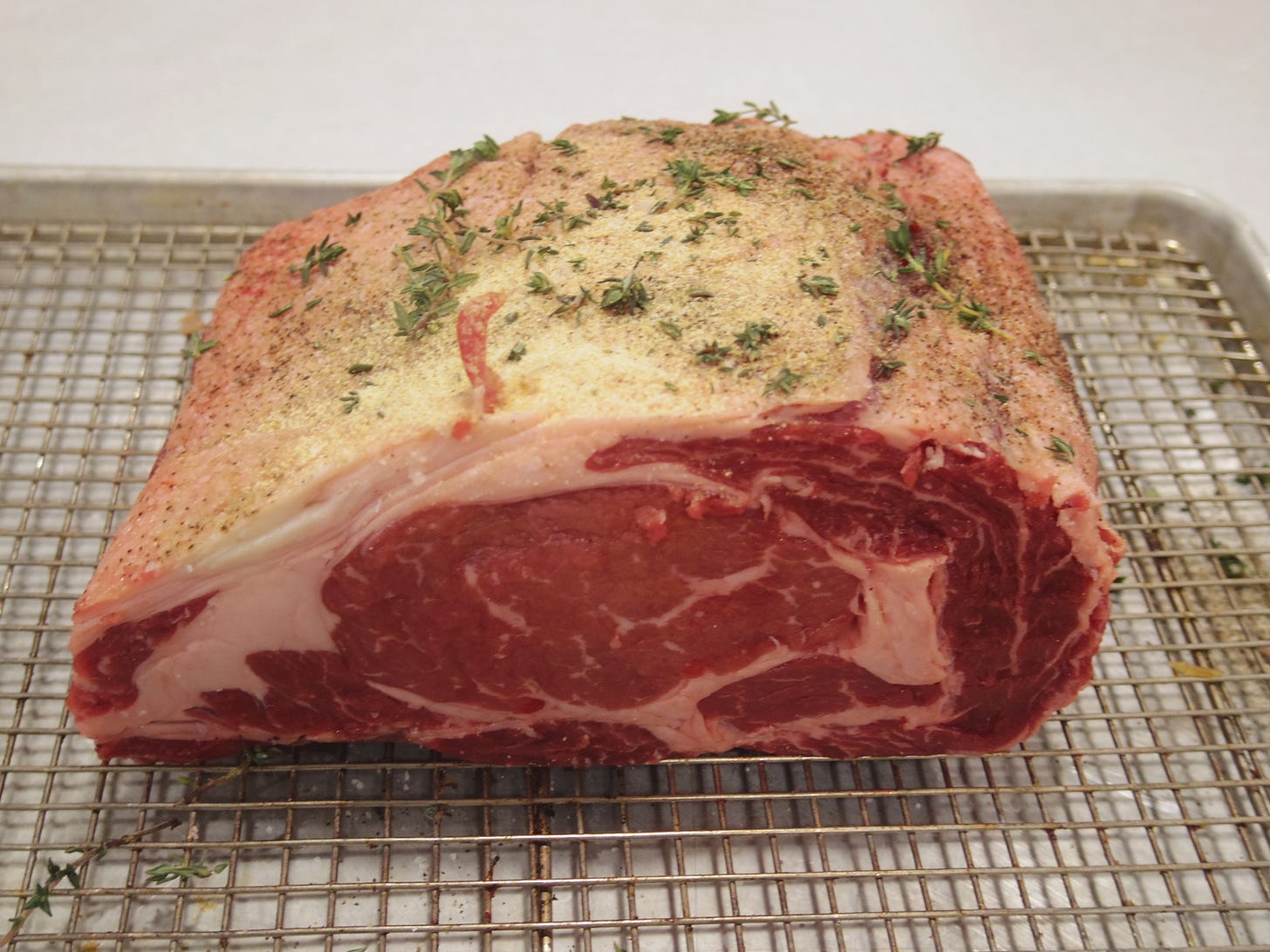In 1994, I took a job at the Highlander Hotel in Iowa City. The hotel ran a very nice supper club and they had an opening for a broiler cook. I had met the executive chef a couple of months before, and he pretty much hired me on the spot. The Highlander Hotel was well known for offering a wide variety of steaks which were all hand cut every day. But the menu item that really put The Highlander Supper Club over the top was that they prepared and served the best prime rib for miles around. Every day, the kitchen staff roasted 30-60 pounds of boneless prime rib every day. This is where my prime rib love story begins.
For those readers who are not too familiar with a cow’s anatomy, prime rib is a roast cut from ribs 6-13 on the upper rib cage. Since those muscles are not used as often as other muscles (i.e. legs, neck, etc) the meat is well marbled and very tender.
To say that working at the Highlander Supper Club was hectic was an understatement. It was especially busy after the home football and basketball games for the University of Iowa football and basketball games. To run the line most nights, it took four cooks. I often worked as the broiler cook, or the expediter/fryer cook. Almost every night somebody, whether it be the waiter or waitress who mistakenly put in the wrong order, or chef would make a mistake and and not read the food server’s order correctly, or a customer who originally wanted the prime rib and decided to change their mind, would have an untouched slab of beautifully perfectly cooked prime rib that we could not serve to a customer. At the end of my first night, while we were cleaning up, I noticed the untouched prime rib and asked what we should do with it. I was told that I could either throw it away in the garbage or eat it. Being very hungry that night, I chose the latter, savoring every bite.
And so began, a one year carnivorous love affair with prime rib. Almost every night around 9:00 I would treat myself to a beautiful slice of prime rib. Sometimes if I was feeling extra indulgent, I would top it with bearnaise sauce. At the time, I was only making $8.00 an hour and living in a small studio apartment which cost me $240.00 a month, but being able to enjoy a piece of prime rib every day, gave me the feeling that I was eating like a king. Some nights, if I was feeling especially decadent, I would ladle some bearnaise sauce over it.
And if thee was any prime rib roast leftover from the previous day, we would use it to make some type of beef dish (stir fried beef, beef stroganoff, pepper steak, beef and noodles, etc.) for the employee meal which was served at 4:00.
I could have worked at that the Highlander Supper Club as long as I wanted to, but after about a year, I felt that I had learned all that I could as a broiler cook, so I resigned and left looking to take my culinary career in some other direction. And in leaving the Highlander, I ended my love affair with prime rib.
____________________________________________________________________________
This might be a speculation, but very few people have prepared more prime rib than me. And still to this day I can get very worrisome about roasting prime rib. Prime rib is a really expensive cut of meat. Since a rib roast is so expensive, it is almost always, it is usually prepared and served for a major holiday or event like Christmas, Valentines Day, weddings, etc. And after I have spent a small fortune, on a rib roast (bone in or boneless), I definitely want to make sure that it is as perfectly prepared as possible. recent years, when preparing prime rib, I typically use one of two methods. One xmethod would be to roast the prime rib at 250 degrees. The other method would be to place the rib roast in a 500 degree oven for 30 minutes and then turn off the oven and continue to let the residual heat roast the meat to the desired temperature.
A few days ago, I pulled out a 10 pound piece of prime rib and was debating which of these methods I should use to cook it. Then I had the idea that it might be interesting to cut the prime rib in half and roast one half at 250 degrees, and placed the other half in a preheated 500 degree oven. Both pieces were in the oven for a total of 3 hours and while my experiment wasn’t totally scientific. These were the results:
ROAST #1: 250 DEGREES FOR 3 HOURS
For this method, I The seasoned the roast with kosher salt, pepper, garlic powder, and fresh thyme. placed a 4 1/2 pound rib roast in a preheated 250 degree oven. I roasted the rib in the oven for 3 hours.

ROAST #2: 500 DEGREES FOR 30 MINUTES, AND THEN LETTING IT SIT FOR 2 1/2 HOURS
For this method, I also seasoned a 5 1/2 pound rib roast with kosher salt, pepper, garlic powder and fresh thyme. I placed the roast in a 500 degree oven for 30 minutes. Then shut off the oven and left the roast in the oven for 2 1/2 hours. Note: In using this methods, do not under any circumstances open the door for any reason.


MY OPINION ON WHICH METHOD IS BETTER?
The internal temperature for roast #1 was 130 degrees. When I sliced the roast, it was a perfect medium rare.
The internal temperature for roast #2 was 120 degrees. Obviously a bit more rare, but it also was on pound heavier that roast #1. I put the roast back into a 500 degree oven for another 15 minutes which increased the temperature to 130 degrees.
WHICH METHOD IS BETTER?
After roasting 2 different rib roasts in 2 different ovens, I came to the realization that the cooking method really isn’t what is important. Both methods produced a perfectly cooked prime rib. What really matters is in preparing prime rib is being attentive to the internal temperature. In other words, put the roast in the oven and check it regularly. So keep your meat thermometer handy and calibrated. Stick the thermometer in the middle of the roast and let it tell you how well done the roast is. ;
Now I understand that in method #2, it is specifically stated that the cook specifically to not open up the door thus not allowing one to check the internal temperature at any time during the cooking process. I found that once I closed my oven door, I found myself in agony, wanting to open the door to see what the internal temperature was. If I use this method in the future, I have determined that I will use one of those digital thermometers with an oven proof cable that and in that way, I can observe the internal temperature as it is cooking.
Also, I would like to note that when I cook prime rib, I my goal is to cook it to a perfect medium rare. In my experience, most people are very happy with their prime rib served medium rare. In doing so, am always conscientious guests that would prefer their prime medium or medium well, and make sure that they are served an end cut or a piece nearer to the end.
Rare: 120-129 degrees, Bright red center, lukewarm. Medium Rare: 130-134 degrees, Bright red center, edges pink Medium 135-144 degrees, Center is light pink, outer edges are brown. Medium Well 145-154 degrees,very center is very slightly pink, but mostly brown. Well Done 155-164 degrees, Roast is uniformly brown throughout.
To be honest, I found no difference in either roast. They both tasted great and people that I was serving could not differentiate one rib from the other. The main takeaway from this experiment is that prime rib may be expensive, but it is incredible any way that you choose to cook it.







Share this post